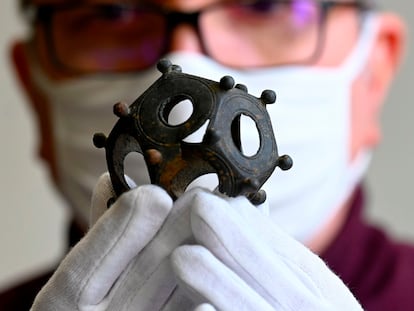Hadrian’s Wall treasure trove reveals first known sex toy from Roman world
A University of Cambridge study has identified a wooden object found at the Vindolanda fort in northern England as a dildo dating from the era of Emperor Antoninus Pius


The emperor Hadrian (76-138 AD) ordered the construction of a vast defensive system in the north of the province of Britannia in the year 122 AD to protect Rome’s troops against the warlike Picts and to extend its imperial domination over the island with greater security. This structure would later become known as Hadrian’s Wall, an impressive military complex stretching 73 miles from the North Sea to the Irish Sea and protected by moats, towers with permanent garrisons of troops, forts for infantry and cavalry, a road for internal movements and imposing gates. The most famous of all these constructions is the Vindolanda fort, which was first excavated in the 1930s, and in whose peripheral landfill numerous objects providing information about the military and social life of its inhabitants have since been discovered.
The troops stationed there lived with their spouses. One of the most recent items found at the site was a wooden sex toy – the first-known such discovery from the Roman world – which was initially considered to be a tool for darning. However, Cambridge University archaeologists Rob Collins and Rob Sand note in their report “Touch wood: luck, protection, power or pleasure? A wooden phallus from Vindolanda Roman fort” that it was almost certainly a dildo, possibly belonging to the wife of a high-ranking military commander.
The study conducted by Collins and Sand, which was published last Monday in the academic journal Antiquity, notes that the anaerobic conditions of the ditches where the fort’s inhabitants dumped their waste have allowed numerous organic objects to be preserved, “including wooden writing tablets and a pair of leather boxing gloves.” Between 1970 and 1980, for example, more than 500 wax tablets were found containing everything from invitations to a birthday party to requests for more beer to be sent to the soldiers.
In the Roman world, two- and three-dimensional representations of phalluses were very common. They held not only an erotic function, but also a magical and apotropaic one. It is relatively easy to find them on mosaics, frescoes, crockery and walls. Most of them were made of metal, stone, bone and, occasionally, ceramics. They have been found on the walls of public and private buildings, but the most numerous ones were portable. These could be worn as earrings or pendants, but they were also crafted with decorative handles.
Finding large wooden dildos is a rare occurrence, say the experts, noting that when they are discovered they are generally made of stone or metal due to the easy decomposition of wood. That is to say that they have been produced, but do not survive the ages. However, conditions at Vindolanda “have preserved some 2,000 portable wooden objects, primarily dated to later first- and second- century AD contexts,” the study notes.
The erotic toy found at Vindolanda, which served as an auxiliary fort to Hadrian’s Wall itself, has been registered under the name W-1992-1062. It is six inches (16 centimeters) long and was carved from ash wood. It has a wide cylindrical base and its end represents the glans. However, the exact original measurements are impossible to determine, write the Cambridge researchers: “Archaeological wood is prone to shrinkage and warping, and all measurements given here are post-conservation, probably representing an underestimate of the original dimension.”
The Vindolanda fort was made up of nine separate constructions of different sizes and was in use between the end of the 1st century AD to the middle of the 5th century AD, although it may have been repurposed and remained active until the 10th century AD, long after the Romans had abandoned Britannia. Its eventual demolition sealed the deep ditch-like refuse dumps that surrounded it and created the perfect conditions for the preservation of objects left there. The dildo in question has been dated to between 165 and 200 AD, placing it within the reign of Antoninus Pius, Hadrian’s successor. In addition to the dildo, 217 sandals, 25 beauty accessories, 14 combs, 22 pencils for wax engraving, eight weapons, five coins and four game pieces were found in the same ditch.
The Cambridge University study notes that “repeated use of wooden objects can damage or smooth their surfaces, depending on the intensity and frequency of handling and/or the time over which they were used. Other factors, such as the transfer of sebum from the skin during handling, may lead to the polishing of surfaces,” as is the case with the Vindolanda find. “A handle from a framesaw, also made of ash, for example, suggests that repeated gripping during the sawing motion, combined with the oils from the skin, has smoothed the wood, The original carved surface of the handle shows signs of a polishing effect, the surface retains a slight sheen, and it feels smoother to the touch at exactly the point where the user’s grip would have been strongest.”
“The object’s overall level of preservation is generally very good,” suggesting that it was not “exposed to the elements for any extended period before deposition,” the report continues. “The wooden phallus may originally have been positioned to project from, and provide protection for, the entrance to one of the key buildings inside the fort, such as the commanding officer’s house (praetorium), the headquarters building (principia) or the granaries (horrea). The lack of surface weathering, however, suggests that, if used in such a way, the phallus was either kept indoors or in a sheltered location, or at least was not placed in an exposed position for any appreciable length of time.”
The researchers conclude that, by virtue of the wear on the object, which is more pronounced on both ends than in the middle, it was used by a woman to stimulate herself and not by a man, but that no “definitive interpretation” of the Vindolanda phallus is possible.
Sign up for our weekly newsletter to get more English-language news coverage from EL PAÍS USA Edition
Tu suscripción se está usando en otro dispositivo
¿Quieres añadir otro usuario a tu suscripción?
Si continúas leyendo en este dispositivo, no se podrá leer en el otro.
FlechaTu suscripción se está usando en otro dispositivo y solo puedes acceder a EL PAÍS desde un dispositivo a la vez.
Si quieres compartir tu cuenta, cambia tu suscripción a la modalidad Premium, así podrás añadir otro usuario. Cada uno accederá con su propia cuenta de email, lo que os permitirá personalizar vuestra experiencia en EL PAÍS.
¿Tienes una suscripción de empresa? Accede aquí para contratar más cuentas.
En el caso de no saber quién está usando tu cuenta, te recomendamos cambiar tu contraseña aquí.
Si decides continuar compartiendo tu cuenta, este mensaje se mostrará en tu dispositivo y en el de la otra persona que está usando tu cuenta de forma indefinida, afectando a tu experiencia de lectura. Puedes consultar aquí los términos y condiciones de la suscripción digital.
More information
Archived In
Últimas noticias
Maduro to be tried in the US for narcoterrorism and corruption
Maps of the US attack on Venezuela: Targets, airspace and deployed fleet
Venezuelans in exile: ‘This could be the end of a very dark chapter for Venezuela, but also the beginning of a time of uncertainty’
Key points of the military attack on Venezuela: Early morning bombings and a ‘captured’ president
Most viewed
- Alain Aspect, Nobel laureate in physics: ‘Einstein was so smart that he would have had to recognize quantum entanglement’
- David King, chemist: ‘There are scientists studying how to cool the planet; nobody should stop these experiments from happening’
- Mexico completes its trade shift with the entry into force of tariffs on China and countries without trade agreements
- Reinhard Genzel, Nobel laureate in physics: ‘One-minute videos will never give you the truth’
- Oona Chaplin: ‘I told James Cameron that I was living in a treehouse and starting a permaculture project with a friend’










































